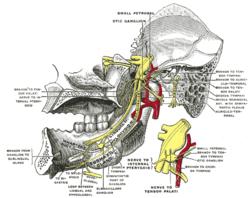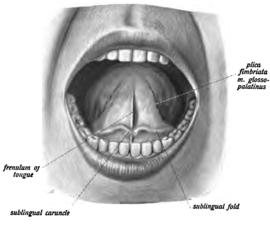| Submandibular duct | |
|---|---|
 Dissection, showing salivary glands of right side. (Labeled as "submaxillary duct", but is identified as "submandibular duct" in newer sources.) | |
 Mandibular division of trifacial nerve, seen from the middle line. The small figure is an enlarged view of the otic ganglion. ("Wharton's duct" labeled in lower left.) | |
| Details | |
| Identifiers | |
| Latin | Ductus submaxillaris |
| TA98 | A05.1.02.012 |
| TA2 | 2811 |
| FMA | 86266 |
| Anatomical terminology | |
The submandibular duct or Wharton duct[1] or submaxillary duct, is one of the salivary excretory ducts. It is about 5 cm. long, and its wall is much thinner than that of the parotid duct. It drains saliva from each bilateral submandibular gland and sublingual gland to the sublingual caruncle at the base of the tongue.[2]
Structure
It arises from deep part of submandibular salivary gland. It begins by numerous branches from the superficial surface of the gland, and runs forward between the mylohyoid, hyoglossus, and genioglossus muscles. It then passes between the sublingual gland and the genioglossus and opens by a narrow opening on the summit of a small papilla (the "sublingual caruncle") at the side of the frenulum of the tongue. It lies superior to lingual and hypoglossal nerves.
Function
The submandibular ducts drain saliva from the submandibular glands, and the sublingual glands to the sublingual caruncles at the base of the tongue.[3]
History
It was initially described by the English anatomist Thomas Wharton ( 1614-73) and is sometimes referred to by his name.[4]
References
This article incorporates text in the public domain from page 1135 of the 20th edition of Gray's Anatomy (1918)
- ^ Wharton's duct at Who Named It?
- ^ Ten Cate's Oral Histology, Nanci, Elsevier, 2013, page 255
- ^ Ten Cate's Oral Histology, Nanci, Elsevier, 2013, page 255
- ^ Wharton T (1656). Adenographia: sive glandularum totius corporis descriptio. London: Wharton. pp. 128–137.
External links
- Anatomy figure: 34:03-05 at Human Anatomy Online, SUNY Downstate Medical Center
- MedicalMnemonics.com: 329
